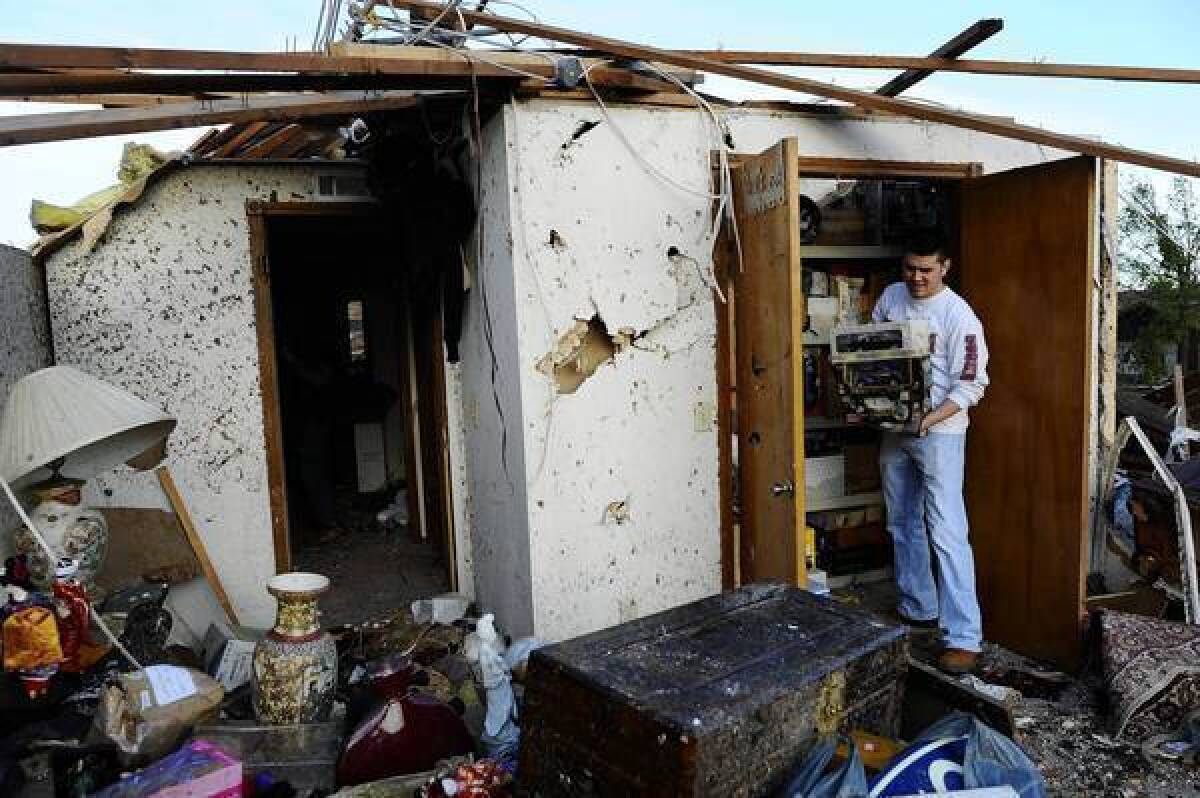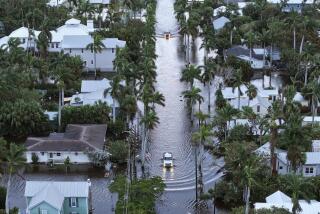Oklahoma tornado leaves misery and relief in its twisted path

MOORE, Okla. — The tornado zigzagged down the two-lane road with heartbreaking imprecision.
It mostly bypassed Marlene Moan’s house, blowing off part of her roof but failing to topple even one framed picture inside. But when she peered out of her back window Tuesday, she saw sheet metal choking utility poles and ladders dangling from mangled trees.
Just down the road, the twister yanked the pink insulation out of the walls of Justin Lemmon’s childhood home and caked it to a tree. It reduced Rebecca Garland’s house to a doorway and a mostly empty brick shell, from which she and her husband unearthed a hatbox and a drawer heavy with change.
In many ways, this small patch of east-west road reflected the strange nature of tornadoes. They carve both a path of sorrow and one of relief, perhaps tinged with a little guilt.
Here in a region known as Tornado Alley, the threat of twisters looms every spring. From a young age, residents learn what a wall cloud is and how to duck and cover when sirens yowl.
In 1999, a tornado smashed into this suburb of Oklahoma City — “Home of Toby Keith,” its water tower boasts — and killed 36 people. It also coiled down the road where Moan, Lemmon and Garland lived, sparing all their homes.
But as folks here know all too well, not everyone can dodge every tornado. Especially not one as fierce as the funnel cloud that whirled through Monday. Death toll so far: 24, including nine children.
On Monday, when sirens started to wail, Rebecca Garland, 63, and her husband, Dan, hustled down a metal ladder into the storm cellar they built after the 1999 tornado. Suddenly, silence.
Dan took the opportunity to run next door, where his 91-year-old mother lives, and persuade her to take refuge in the cellar. Seven neighbors joined them. Two dogs as well, though his mother’s dog, Daisy, refused to budge. Maybe a minute before the funnel cloud spun through, someone slammed the door shut.
First, the lights went out. Then the cellar trembled. Dan, 65, and two other men gripped the door handle, their faces pinched in concentration and their arms straining to hang on.
The twister whirred like a drill. Garland’s ears popped as she hugged her neighbors, whose eyes welled with tears.
“Jesus, Jesus, Jesus!” she screamed.
Again, silence. The tornado had pirouetted elsewhere. Garland poked her head out of the cellar.
Her section of the street, which is known as SW 149th Street in Oklahoma City, had been transformed into a scrap yard: 5-foot-tall piles of wood chunks, knots of electrical wire, toppled trees. Garland looked in the direction of her 2,500-square-foot house — or rather, where it used to be.
Her mother-in-law asked: Can we check on my home?
“You don’t have a house, honey,” Garland told her. “It’s gone.”
They later found Daisy’s body.
Until nightfall, the Garlands mostly wandered around their neighborhood, a speed bump on the tornado’s 20-mile path. The area had a ghostly quality. Here, a white boat rested atop the remains of a house. There, bowling pins stood upright in a collapsed bowling alley.
The Garlands spent the night with their son, who lives nearby. Rebecca woke up in the wee hours, sobbing.
Tuesday dawned.
Just a little more than a mile up the street, which in Moore is known as SW 19th Street, Moan marveled at what the tornado didn’t do. Moan, 68, had been at work during the twister and expected to find her brick home in pieces. Instead, she found only minor damage to her roof and garage door. There were no cracks in her large living room mirror.
Moan has a collection of figurines, miniature swans. They hadn’t budged.
“Everything I have is still in place,” Moan said, her expression one of astonishment. “It’s all here.”
Then her daughter discovered the wreckage out back. The lawn shimmered with broken glass. The wind billowed stray pieces of clothing. Even the road hadn’t escaped the tornado’s fury; it had scooped out chunks and splattered the rest with mud.
“I feel blessed,” Moan said.
A few blocks west, however, the tornado had gutted the home of Lemmon’s parents. His friend Jordan Beheler, 24, pawed through photos and academic trophies, helping Lemmon salvage mementos of their childhood. The twister had shredded so many of them.
Their elementary school is gone. So is the baseball field. So is the black Ford Mustang that Lemmon used to drive. The horses at the nearby track, all dead.
“Just looking around here, it’s our entire lives,” Beheler said. “Everything we grew up with is gone.”
On Tuesday morning, Garland also returned to her sliver of SW 149th Street. She wore a borrowed pink shirt and pajama bottoms. Rain pelted her face and showed no signs of slowing as she tromped through the ruins.
“It’s just stuff, you know, and I’m thinking of the little kids at school and their parents,” Garland said. “They’re going to have to bury their kids.”
Still, it pained her to see what little remained. A ceiling fan, its light bulbs intact. Some costume jewelry.
Like Moan, she had a collection of figurines too, characters from “The Wizard of Oz.” In the rubble she found one intact, the Tin Man.
Carcamo reported from Moore and Powers from Los Angeles. Times staff writer Matt Pearce in Moore and Hailey Branson-Potts in Los Angeles contributed to this report.
More to Read
Sign up for Essential California
The most important California stories and recommendations in your inbox every morning.
You may occasionally receive promotional content from the Los Angeles Times.











